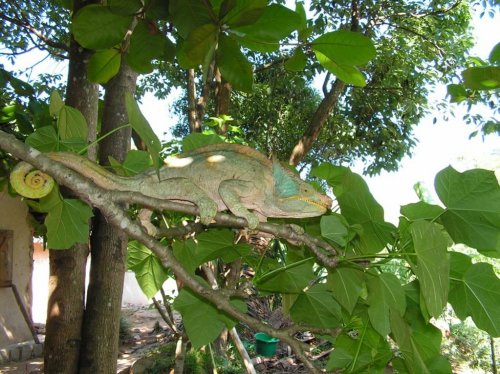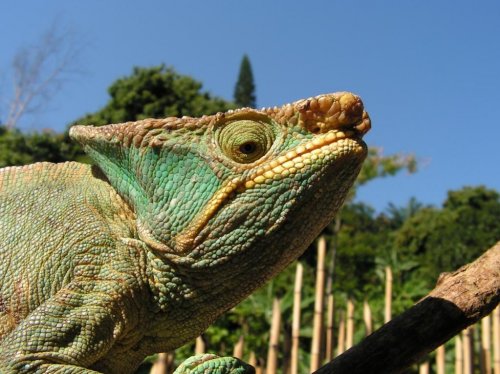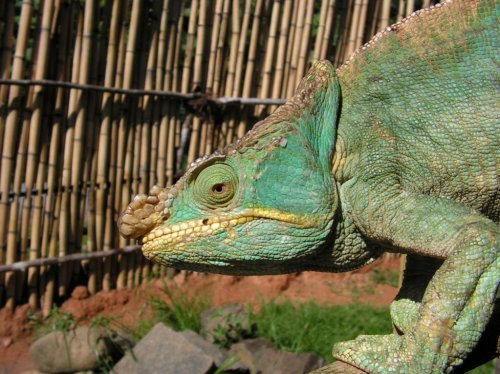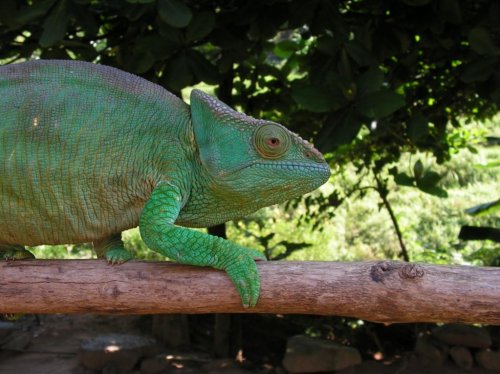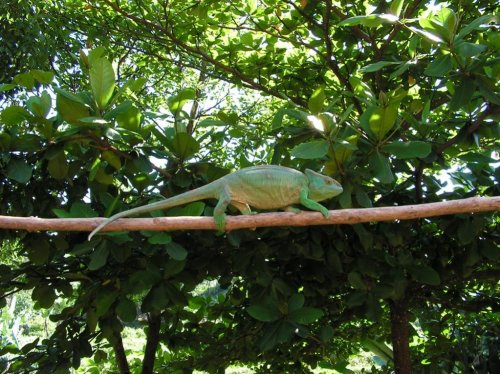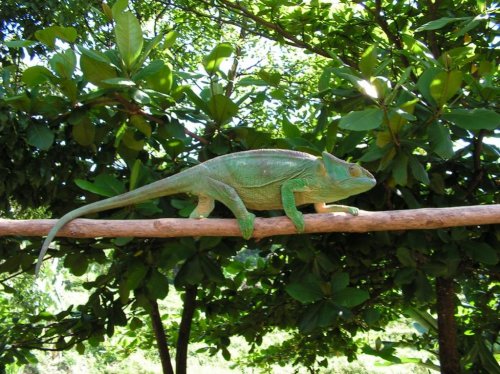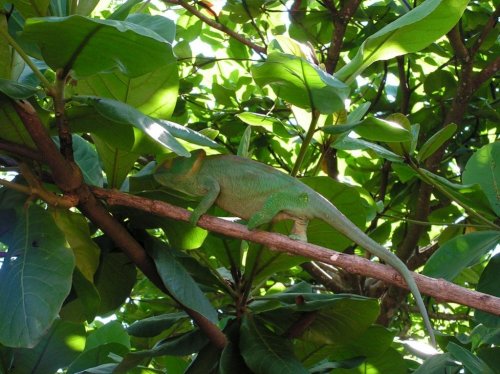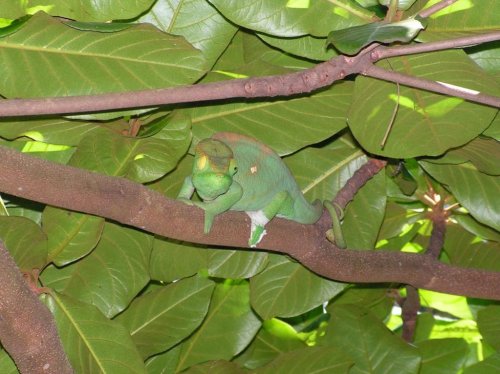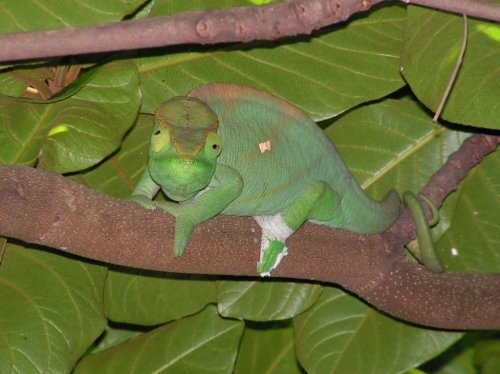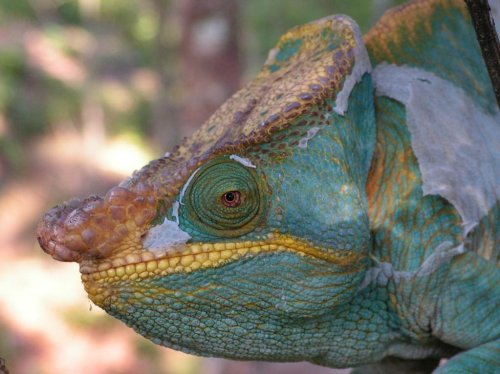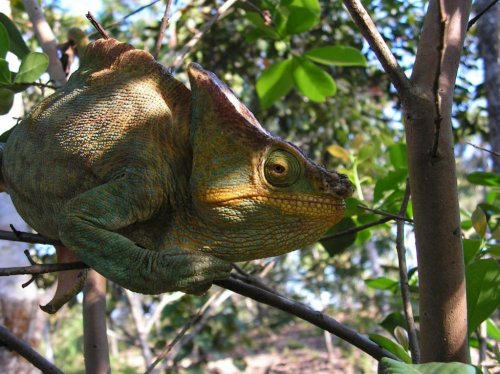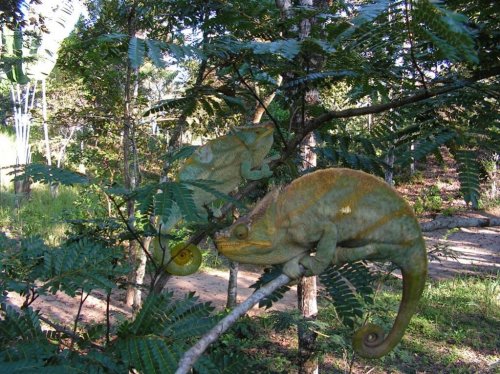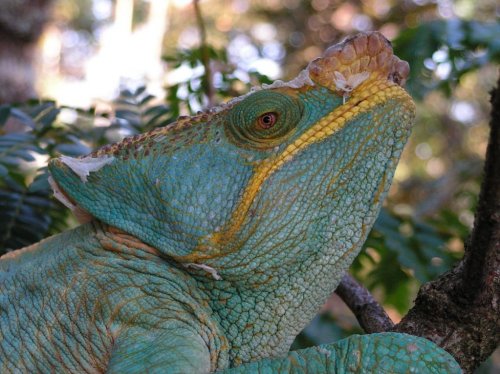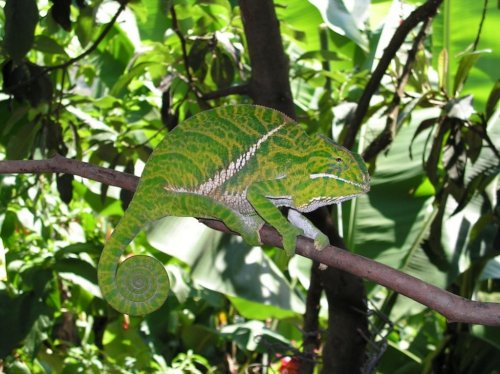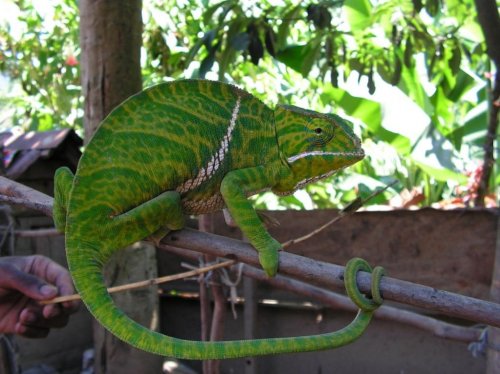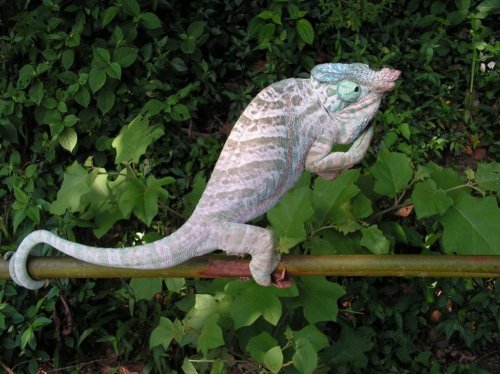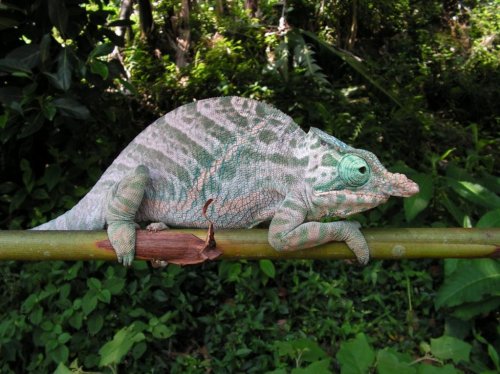Navigation
Install the app
How to install the app on iOS
Follow along with the video below to see how to install our site as a web app on your home screen.
Note: This feature may not be available in some browsers.
More options
You are using an out of date browser. It may not display this or other websites correctly.
You should upgrade or use an alternative browser.
You should upgrade or use an alternative browser.
Calumma parsonii parsonii
- Thread starter rantotro
- Start date
rantotro
Established Member
Let's start with the yellow lips in the surroundings of Ranomafana.
We could find these animals, however, not in the rain forest, but at a height of 450 ms about the sea level in the shade of some of the majority-leafy trees at a brook.
There they live in the care of a former forest supervisor and according to his information they can also reproduce there. He has already found babies and he also showed us the place where the females normally her eggs lay. There I have measured at 25-cm deep 23.2 °C.
The air in the shade of the trees had 29°C, shortly before the summery rainy season. Therefore I look at these values as a temperature maximum for these chameleons and their eggs in the ground.
Indeed, the incubation of eggs yellow lips and the breeding of the Jung's animals has succeeded under the same conditions like with ours orange eyes recently. No especially mountain temperature variations seem to be required here how earlier was sometimes supposed.
The Parsonsman living here was obvious on account of the strenuous district defense, however, in much worse constitution than the females. The availability of water plays, on this occasion, probably a big role. He lives beyond the rain forest presumably constantly in his temperature maximum and, therefore, the water need is higher then. Who must move there more often from the shade around the small district under these few trees to defend, that has to fight also with the heat.
Brooks and rivers are also the preferential settlement area of people. And they put on all around in this case a banana plantation. The rain forest itself is forced back in the inaccessible mountains worse to be managed. A subject, on that I come back later over again. However, this part of the brook was obvious even if small, so however, a good retreat area for the yellow lips Parsons. There is at residential buildings for people likewise the need for shade, which is why these majority-leafy trees stand there. This makes hope that these chameleons can absolutely survive in immediate neighborhood to people.
We could find these animals, however, not in the rain forest, but at a height of 450 ms about the sea level in the shade of some of the majority-leafy trees at a brook.
There they live in the care of a former forest supervisor and according to his information they can also reproduce there. He has already found babies and he also showed us the place where the females normally her eggs lay. There I have measured at 25-cm deep 23.2 °C.
The air in the shade of the trees had 29°C, shortly before the summery rainy season. Therefore I look at these values as a temperature maximum for these chameleons and their eggs in the ground.
Indeed, the incubation of eggs yellow lips and the breeding of the Jung's animals has succeeded under the same conditions like with ours orange eyes recently. No especially mountain temperature variations seem to be required here how earlier was sometimes supposed.
The Parsonsman living here was obvious on account of the strenuous district defense, however, in much worse constitution than the females. The availability of water plays, on this occasion, probably a big role. He lives beyond the rain forest presumably constantly in his temperature maximum and, therefore, the water need is higher then. Who must move there more often from the shade around the small district under these few trees to defend, that has to fight also with the heat.
Brooks and rivers are also the preferential settlement area of people. And they put on all around in this case a banana plantation. The rain forest itself is forced back in the inaccessible mountains worse to be managed. A subject, on that I come back later over again. However, this part of the brook was obvious even if small, so however, a good retreat area for the yellow lips Parsons. There is at residential buildings for people likewise the need for shade, which is why these majority-leafy trees stand there. This makes hope that these chameleons can absolutely survive in immediate neighborhood to people.
Attachments
MSAquatics
New Member
Great information, very, very interesting. The majority of us don't have the opportunity to travel to Madagascar or south Africa to take such valuable data. I feel like we're getting a private tour on the Discovery Channel.
Great thread!
Leland
Great thread!
Leland
rantotro
Established Member
rantotro
Established Member
MSAquatics
New Member
Those balteatus pics are amazing, we don't see pictures of them very often. I've never seen a female show those patterns, usually they are a solid green.
Leland
Leland
The yellow muster is after my opinion stress color. Many parsonii and globifer females show some very similar pattern if they feel "disturbed" and even in nature when you step close to them in few second they will show something similar although previously were plain green. I have parsonii female that display something similar when I put hand without pincette or syringe in terrarium immediately (with pincette expect food, with syringe water). Interesting is that second female living in same terrarium never displays it just if I need "grip" it to move (actually I need force it a bit move to hand so I can manipulate).
Interesting is that it seems to me to be sex related, males do not show such "yellow fear".
Interesting is that it seems to me to be sex related, males do not show such "yellow fear".
MSAquatics
New Member
When you incubate your eggs, do you have another lid on the container, as well as the cups over the eggs? Just curious how you keep the vermiculite from drying out on the days you don't water the eggs. I really like the way you incubate the eggs from the pictures. I might possibly have melleri eggs here in the next month, and while their incubation period is obviously much shorter, I'd like to try to replicate what you are doing for the best hatch rates and health of the neonates.
Leland
Leland
rantotro
Established Member
We are breeding now like I wrote on page 12, with a lid on the box but without the cups (this was an old idea to keep condensation water away from the eggs).
https://www.chameleonforums.com/calumma-parsonii-parsonii-84839/index12.html
The hatching rate of the eggs that survives the first 2 months is near 100% now. Much better like with the dry method with the cups.
But we do it because of the thick egg shell of C.parsonii. I don't know if it is the right treatment for eggs of T.melleri or other chameleon species. If the egg shell is thinner the egg can burst.
https://www.chameleonforums.com/calumma-parsonii-parsonii-84839/index12.html
The hatching rate of the eggs that survives the first 2 months is near 100% now. Much better like with the dry method with the cups.
But we do it because of the thick egg shell of C.parsonii. I don't know if it is the right treatment for eggs of T.melleri or other chameleon species. If the egg shell is thinner the egg can burst.
MSAquatics
New Member
I meant to ask earlier, but forgot, why do you only use a UVB bulb for 20min/day with the indoor cages, and not all day? Is it to save energy, or do the parsonii develop edema if exposed to too much UVB, or do they still receive some natural light through the windows you mentioned? When I upgraded my UVB bulbs to stronger Arcadia bulbs in my melleri free range, I noticed they both began to show signs of gullar edema initially, presumably from an increased level of vitamin D3 due to the lights?
Leland
Leland
rantotro
Established Member
Not per day, 20 min UVB with Ultravitalux 300W per week is enough.
But we are using Vitamin D3 (Korvimin ZVT) and Calcium (Herpetal mineral) in the supplement on the insects like I wrote in page 9.
https://www.chameleonforums.com/calumma-parsonii-parsonii-84839/index9.html
But even when we used the Ultravitalux for maybe an hour, because I had forgotten to put the light off, the animals did not have problems. It surely depends from the distance that should be minimum 80cm and the temperature that should be maximum 30°C including the heat from the Ultravitalux.
For daily basking we are using 20-50 W Halogen flood lamps 10cm over the cages the whole day. But all UVB is filtered away by a glass at these halogen lamps. So the skin of the chameleons can't be burned. Try it with your hand. If it is painful for you it is painful for the chameleon too. If it is still warm and enjoyable this is also the right distance for your chameleon.
With a strong UVB part a burning of the skin happens fast in these short distances.
So I think it's better to use a short duration of UV light and only a white light to warm up for the whole day without UV.
But we are using Vitamin D3 (Korvimin ZVT) and Calcium (Herpetal mineral) in the supplement on the insects like I wrote in page 9.
https://www.chameleonforums.com/calumma-parsonii-parsonii-84839/index9.html
But even when we used the Ultravitalux for maybe an hour, because I had forgotten to put the light off, the animals did not have problems. It surely depends from the distance that should be minimum 80cm and the temperature that should be maximum 30°C including the heat from the Ultravitalux.
For daily basking we are using 20-50 W Halogen flood lamps 10cm over the cages the whole day. But all UVB is filtered away by a glass at these halogen lamps. So the skin of the chameleons can't be burned. Try it with your hand. If it is painful for you it is painful for the chameleon too. If it is still warm and enjoyable this is also the right distance for your chameleon.
With a strong UVB part a burning of the skin happens fast in these short distances.
So I think it's better to use a short duration of UV light and only a white light to warm up for the whole day without UV.
MSAquatics
New Member
The ultra vitalux is a much more powerful light than the 6% Arcadia lights most of us are using over our cages everyday. How many cages can it light at one time?
Leland
Leland
Action Jackson
Chameleon Enthusiast
This is by far the best and most informative information I have ever seen on Parsonii!!!
Thank a you so much for sharing all this information and the beautiful pictures!
I agree. Andreas has been a great source of information on Parsonii.
Saldarya
Established Member
The ultra vitalux is a much more powerful light than the 6% Arcadia lights most of us are using over our cages everyday. How many cages can it light at one time?
Leland
Leland, as you may already know, this bulb that Andreas is using is a very powerful UV emitter with a spot effect (halogen as opposed to linear bulb).
To that point, it could only light one cage at a time in its area of spot effect.
In addition, it seems this bulb is only made and sold for European use.
I will say that I am using the 6% Arcadia bulb over my Parsons cages. The bulb is 4" above the screen in a 5' tall cage. The animals closest perch gets them within 10" of that top of screen, with an average reading from a Solar meter of 45 µW/cm².
That being said, they are seen to bask directly in that UV light very minimally. As Andreas info would suggest, it does not seem they need a large amount of UV exposure as we are used to with other species like pardalis.
In addition, to make sure all info is clear, I am providing supplemental D3 in the form of the Repashy LoD product once a month and indoor Minerall once a month.
Hope that provides you some comparable info in regards to the Arcadia Bulb you are using.
On a side note, I use them for all of my different species and I do not believe that they would lead to Edema, at least I have not witnessed that. I would look elsewhere such as gut load and other areas for over use of vitamins.
Regards,
MSAquatics
New Member
Bobby,
Thanks for the info. The ultra vitalux is available in the US, it runs about $75 a bulb. You would need a transformer to step it up to 220-230v, and I think they run about $35. I was curious if he could light 3-4 cages at a time, or if it's just used 20min per cage individually. While it adds another task to do weekly, it would save considerable amounts of energy to only light the parsonii once a week instead of providing say 12hours a day everyday with fluorescents.
I'm not sure what caused the initial edema in both my melleri, it just was coincidentally when I changed my reptisun 5.0's to the Arcadia 6% that it appeared. Unless the crickets I feed have been previously raised on a high mineral diet or one that contains high D3. I only supplement minerals and D3 twice a month.
I'm storing all this great information, with the hopes to obtain a few parsonii within a year or two myself.
Leland
Thanks for the info. The ultra vitalux is available in the US, it runs about $75 a bulb. You would need a transformer to step it up to 220-230v, and I think they run about $35. I was curious if he could light 3-4 cages at a time, or if it's just used 20min per cage individually. While it adds another task to do weekly, it would save considerable amounts of energy to only light the parsonii once a week instead of providing say 12hours a day everyday with fluorescents.
I'm not sure what caused the initial edema in both my melleri, it just was coincidentally when I changed my reptisun 5.0's to the Arcadia 6% that it appeared. Unless the crickets I feed have been previously raised on a high mineral diet or one that contains high D3. I only supplement minerals and D3 twice a month.
I'm storing all this great information, with the hopes to obtain a few parsonii within a year or two myself.
Leland
Similar threads
- Replies
- 20
- Views
- 4K

